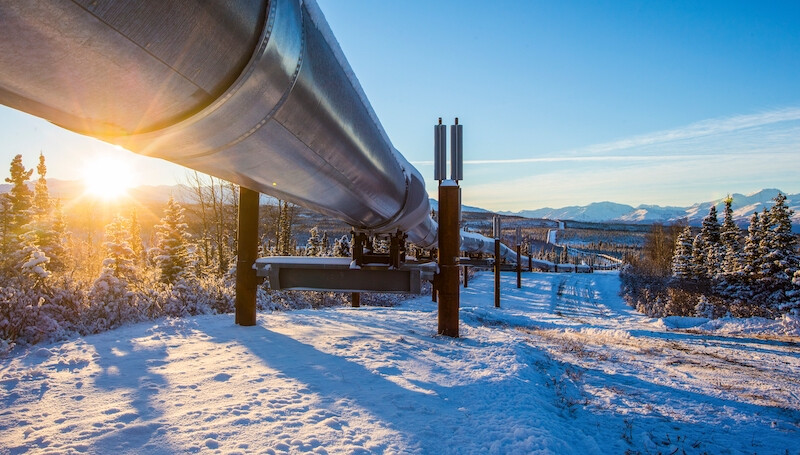
The Trump administration has ushered in a new chapter in the decades-long conflict between commerce and conservation in Alaska, focusing on the state's vast oil and gas potential. However, an analysis suggests that the administration's moves are sending mixed signals to the oil industry, creating a climate of uncertainty.
While the Trump administration has moved to open or reopen vast tracts of government-owned land in Alaska for oil and gas drilling, only a fraction of these opportunities have garnered commercial interest in recent years. Furthermore, the administration's touted 800-mile trans-Alaska gas pipeline project faces uncertain financing, and other administration policies risk deterring potential partners.
President Trump has stated his aim to increase oil and gas production, advancing what he calls “American energy dominance.” The White House has clarified that this term means reducing energy imports from other nations while increasing American energy exports, particularly to allies.
The United States is already the world’s largest producer and a leading exporter of natural gas, and its crude oil production is also among the highest globally. Notably, the American oil industry has thrived under the Biden administration. However, the U.S. still imports over six million barrels of crude oil per day, mostly from Canada.
The Trump administration’s efforts seek to further boost American oil production by expanding drilling access and building related infrastructure. However, in the view of this oil geologist and industry observer, the cumulative effect of the Trump administration’s various actions may be more limited than the president anticipates.
Reopening Leases and Their Implications
On January 20, 2025, one of his first executive actions after returning to office, President Trump declared that the United States would develop Alaska’s oil resources to the “maximum extent possible.”
The previous Biden administration had prohibited oil leases in three areas of Alaska. One was all but about 400,000 acres of the coastal plain region of the Arctic National Wildlife Refuge. Another was 13 million acres in the National Petroleum Reserve-Alaska, a vast federally owned area west of the refuge. The third was 44 million acres of offshore waters in the northern Bering Sea, based on concerns about Indigenous rights and the migration routes of marine mammals.
President Trump swiftly reversed these prohibitions, calling them “an infringement on Alaska’s sovereignty and its ability to responsibly develop its resources for the benefit of the state and the nation.” Furthermore, the Trump administration expanded the area available for drilling by an additional six million acres in the petroleum reserve and 1.1 million acres in the wildlife refuge.
These regions are home to diverse wildlife and Indigenous communities.
Industry Perspectives
From the oil industry’s perspective, these moves offer a mix of welcome opportunities and potentially limited practical impact. The reopening of the northeastern part of the petroleum reserve presents a significant opportunity. Exploration has already identified substantial oil and gas deposits, with indications of further potential.
However, the prospects for development in the wildlife refuge’s onshore areas and the shallow waters of the Bering Sea are less enticing for drilling companies, at least at oil prices not significantly higher than those prevailing in early 2025. Neither area has established production facilities, and while the refuge holds oil and gas potential, it lacks roads and pipelines, and Arctic drilling is particularly costly.
Indeed, the two most recent attempts by the government to lease oil development rights in the wildlife refuge saw scant industry interest. In 2020, the first Trump administration, working with congressional Republicans, overcame decades of legal and political opposition to leasing in the refuge, but a 2021 lease sale flopped when major oil producers in the state stayed away.
A second offering in January 2025 drew no bids from oil companies.
The Pipeline Dream: Can It Be Realized?
What could offer a more tangible benefit to the oil industry is the construction of a large-scale new pipeline to carry natural gas from the Prudhoe Bay region on the Arctic coast more than 800 miles south to a port near Cook Inlet in south-central Alaska.
The idea has a decades-long history, waxing and waning with changing economic conditions, government plans, and Indigenous interests and opposition.
The biggest hurdle has been the lack of a way to transport the North Slope’s natural gas to the outside. Since drilling began in the late 1970s, some has been used locally for heating and to run equipment, but most has been reinjected into the oil-bearing rock to help maintain petroleum production.
However, increased demand and higher prices in Asia suggest that the project could be profitable, despite its current estimated cost of $44 billion. Project plans call for most of the funds to be spent on building a liquefied natural gas export terminal near Anchorage, with the remainder going toward constructing an 807-mile pipeline parallel to the existing trans-Alaska oil pipeline, and a plant at Prudhoe Bay to capture and compress atmospheric carbon for injection into oil-producing formations to enhance production.
The pipeline is designed to carry 3.3 billion cubic feet of natural gas per day, making it one of the largest in North America. The export terminal, to be built near the town of Nikiski on Cook Inlet, would have a capacity of about one trillion cubic feet per year – enough to heat about 15 million homes for a year.
While the pipeline could take two to three years to build, the terminal and carbon capture plant are expected to take around five years longer. While Alaskan-exported natural gas could be shipped to other ports in the United States, it could fetch higher prices in Japan, South Korea, Taiwan, and potentially China.
Unexpected Headwinds
Most of the permits needed for the pipeline and export terminal project have been secured by the Alaska Gasline Development Corporation, a state-owned entity created to advance the project.
However, no company or foreign government has yet agreed to finance it, and despite the Trump White House’s support, there are no indications that the federal government will step in with funding.
Moreover, the Trump administration has created new obstacles for the project. Its widespread imposition of tariffs and the resulting trade war have sent international oil and gas market prices plummeting in early April 2025.
Furthermore, widespread uncertainty about the permanence of tariffs or other international trade restrictions directly impacts the oil industry. Low gas and oil prices and an unstable climate make any project less attractive.
It is true that the Trump administration recently exempted oil and gas from tariffs. However, this is less significant than the broader impact the trade war is already having. Analysts predict that the trade war is pushing the global economy toward recession. Decreased economic activity means less demand for oil and gas, which reduces the incentive for companies to drill new wells and build new pipelines.
To compound matters, the White House has imposed high tariffs on Japan, South Korea, and Taiwan – all potential sources of funding for the pipeline project. Even before the trade war, they were hesitant to back the project. The potential suspension, restoration, or adjustment of tariffs is unlikely to make them perceive the situation as more stable.
Supporters of Alaskan oil and gas development may well wonder if the president is truly on their side. Whether their hopes will become collateral damage in the White House’s economic policies remains to be seen.
[Copyright (c) Global Economic Times. All Rights Reserved.]






























